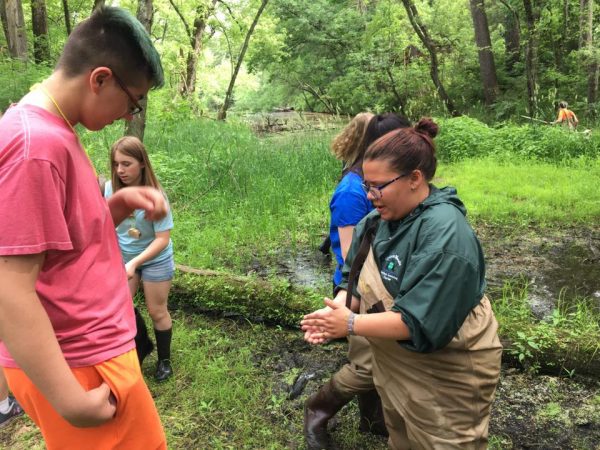We join Marina on the trail, as she helps some campers decipher something decipher something she had never seen before:
 This past week, while trudging through the local wetland, a few curious students lifted tree branches out of the dense algae filled waters.
This past week, while trudging through the local wetland, a few curious students lifted tree branches out of the dense algae filled waters.
“Ah! What is that! It’s slimy!”
“Touch it! No you first!”
I couldn’t arrive at the scene fast enough to discover something I had never seen before. As a Naturalist, you hope to shed light on discoveries made by students. This time, I knew I’d have some research to do before I could describe the gooey blob they pulled out of the water.
Gooey blob. Slimy. That’s all I could think as I stared at this mass of, well, I don’t really know. What I did know was that I was going to make it my mission to find out exactly what they were.
You’re probably thinking to yourself, “Why would I care about a slimy blob in the wetland?”
Well, let me tell you why.
These slimy blobs in our local wetland were amphibian eggs! What amphibian you ask? Well, that’s where it gets complicated. From the research I conducted, it is very likely that the eggs were either frog or salamander eggs. In fact, salamanders and frogs look nearly identical in the first stages of life! Both are classified as amphibians.
The importance of these little friends inside of the wetland is where it really gets good, so stay with me!
Amphibians are incredibly sensitive creatures due to the way they receive oxygen. Many amphibians breathe through their skin, which is pretty cool if you ask me! Unfortunately, by breathing through their skin, they also take in other particles, such as pollutants. If there is pollution within the water, those amphibians’ lives are now in danger. Due to environmental pressures, chemical use, pollution, and many other factors, amphibian populations have been on the decline around the world for many years now. So you can imagine how exciting it is that we found quite a few egg masses within our wetland! This can indicate healthy water and just the right conditions for breeding.
But why do we care?
Amphibians are a great Bioindicator as I mentioned in the previous paragraph, which tells us how healthy a body of water is. Amphibians are also an essential to the food chain. Without amphibians, our pest numbers, (yep, mosquitoes), would increase greatly. We humans rely heavily on amphibians for pest control! They are also eaten by other aquatic organisms, so the absence of amphibians would greatly affect numerous species.
You may be curious as to what our finding means for the future of amphibians. Just because we found some eggs does not mean they are out of the woods yet! It is important to stay informed about the health of local streams and to remain involved to help these important creatures thrive and survive! Below are a few tips on what you can do to stay involved.
- Don’t pollute! This is an incredibly easy solution to do your part in keeping chemicals out of our natural water sources.
- Do your own research! Hop around your local library, or with adult supervision, use the internet to locate organizations that may shed some light on how you can get involved.
- Your backyard can be an amphibian palace! Amphibians love leaf litter, rocks, logs, and a water source. A small pond can be a great family project!
I hope this information has been ribbeting! I sure enjoy writing about such important creatures to our planet. Toaday is the day to get involved! Help our scientists keep our frog populations high, the world will thank you!



